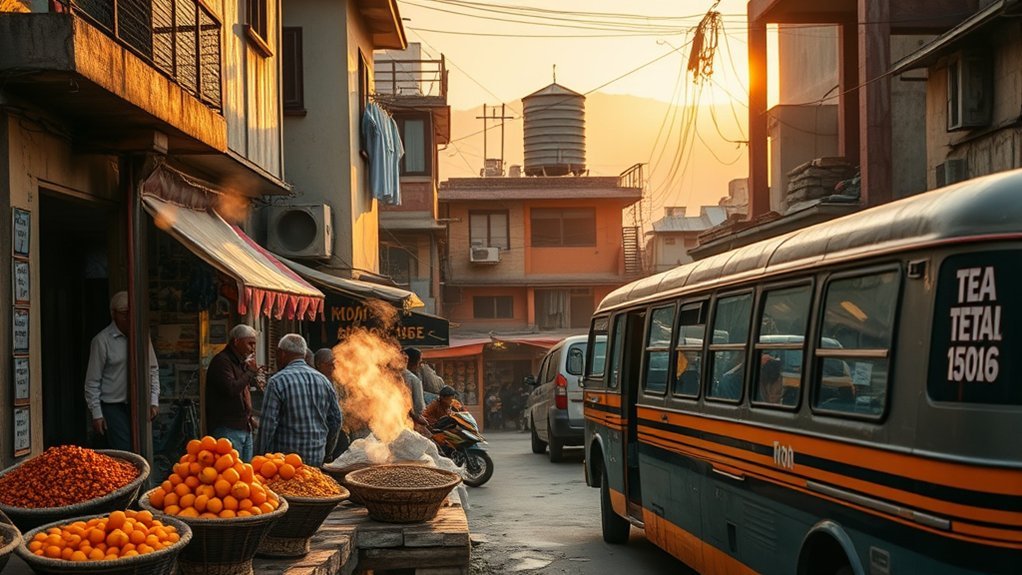You can live comfortably in Nepal on roughly CAD 500–900 a month for day-to-day expenses, or CAD 700–1,400 if you include a modest one- or two-bedroom rental in Kathmandu. Local food, transport and utilities are cheap: street meals cost a few dollars, microbus rides are $0.20–$0.50, and utilities run about $30–$50 monthly. Private healthcare and Western-style rentals add cost, but your money will stretch — keep going to see detailed budget lines and tips.
Cost of Living Overview in Nepal
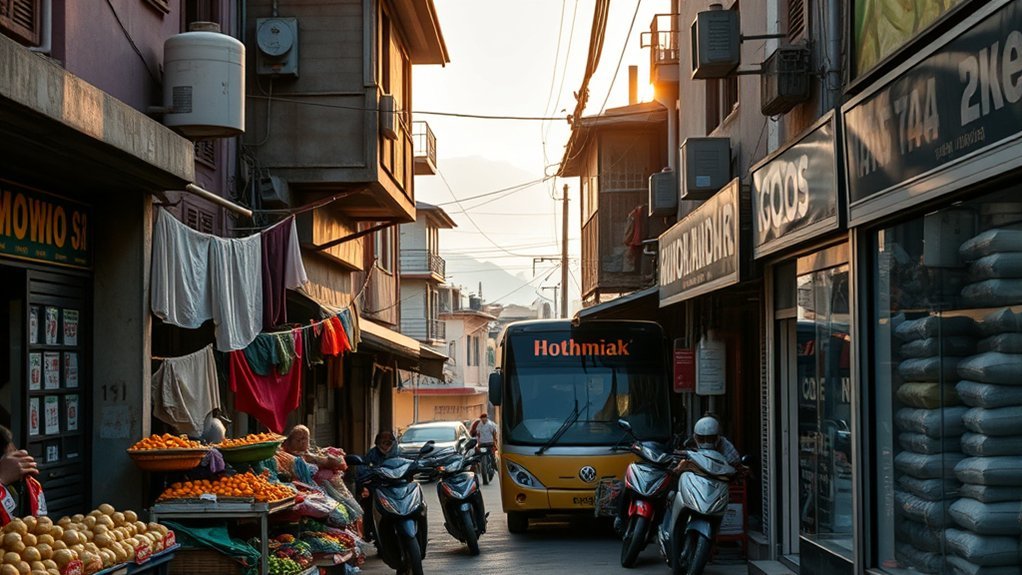
Although prices vary by location and lifestyle, Nepal’s cost of living is generally low: basic food, transport, and utilities run far below Western levels. Rent in Kathmandu averages about $200–$500 for a one‑bedroom and $400–$800 for a two‑bedroom, and local meals cost only a few dollars.
Nepal’s low cost of living makes basics like food, transport, and utilities far cheaper than in the West.
So you can expect overall monthly expenses (excluding rent) to be minimal — many expatriates live on roughly CAD 500 a month for non‑housing costs. You’ll find day‑to‑day expenses consistently lower: groceries, public transit and utilities typically consume a small fraction of Western budgets.
Eating local and using public transport will reduce your monthly outlay; occasional Western goods raise it. Entertainment and leisure are affordable, letting you maintain a modest social life without large expense.
For budgeting, target CAD 500–600 monthly for non‑housing essentials, then add discretionary spending. Track actual receipts for the first three months to fine‑tune your personal cost of living estimate.
Housing and Rental Prices in Kathmandu and Beyond
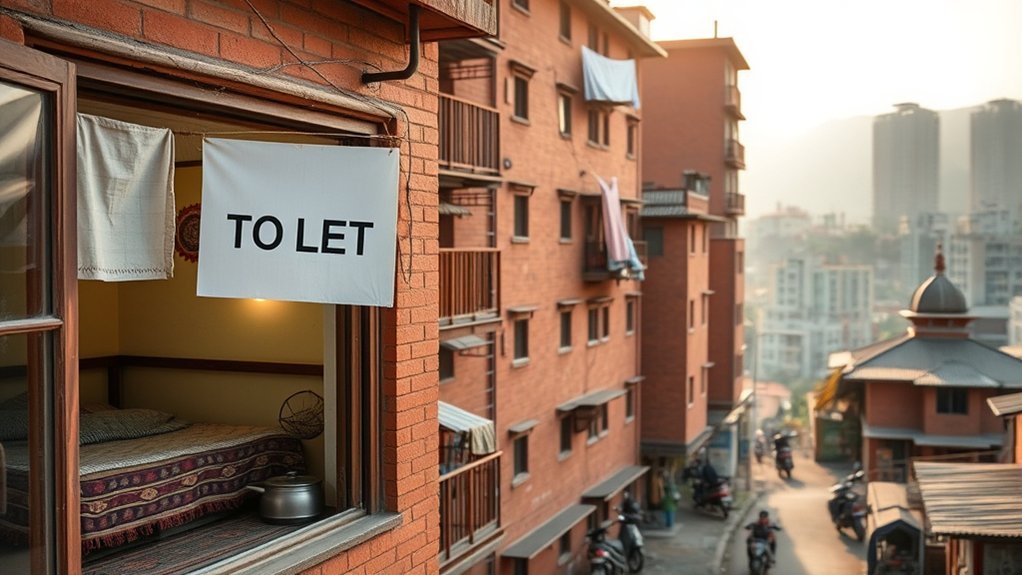
You’ll find one-bedroom city-center apartments in Kathmandu typically cost $200–$500 per month, while two-bedrooms run $400–$800, and prices drop noticeably on the outskirts.
Expat-friendly, furnished one-bedrooms commonly rent for $400–$500 and often include services or extras that raise the price.
Compare specific neighborhoods and amenity lists to decide if a furnished unit’s convenience is worth the premium.
City Center Vs Outskirts
When you compare Kathmandu’s city center to its outskirts, rent differences are clear and measurable: a one-bedroom downtown typically goes for $200–$500/month and a two-bedroom for $400–$800, while suburban prices drop noticeably, making outskirts more budget-friendly for longer-term residents.
You’ll find the city center charges a premium for proximity to services, transportation and attractions, so your living expenses rise with convenience. Outside central zones, rents fall and you get more space for the same money, which suits families or remote workers prioritizing affordability.
Neighborhood-to-neighborhood variation remains significant, so check amenities when budgeting. Note that specially marketed expat units often include furnishings or services that raise costs, so compare raw rent versus all-in monthly outlay.
Typical Expat Rentals
Shifting focus from city-center vs outskirts pricing, you’ll find expat-targeted rentals in Kathmandu usually sit at the higher end of local markets because they bundle convenience and furnishings.
You’ll see one-bedroom options from $200–$500/month, but typical expat one-bedrooms cluster around $400–$500. Two-bedrooms run $400–$800, with typical expat two-beds commonly $500–$700.
Prices depend on neighborhood and amenities; central areas cost more, outskirts are cheaper. Many expat rentals include common appliances—refrigerator, stove, washing machine—and sometimes basic services, reducing setup time and initial expense.
When budgeting, account for the premium on ready-to-move-in units and evaluate whether included conveniences offset higher monthly rent compared with unfurnished or peripheral alternatives.
Furnished Vs Unfurnished Costs
Although furnished units cost more up front, they often save you time and setup expenses: in Kathmandu a furnished one-bedroom typically runs $400–$500/month versus lower rates for unfurnished units, while furnished two-bedrooms are commonly $500–$700 with unfurnished two-beds spanning roughly $400–$800 depending on neighborhood and amenities.
You’ll pay a premium for move-in-ready furnished flats that include fridge, stove, and washer, but you’ll avoid buying appliances. Unfurnished units give lower monthly rents and negotiating room, especially outside the center.
- Compare total cost: furnished rent plus convenience vs. lower unfurnished rent plus setup expenses.
- Check lease details: confirm which appliances are included with furnished units.
- Live farther out to cut rent considerably, furnished or unfurnished.
Grocery and Food Costs (Markets, Restaurants, Street Food)
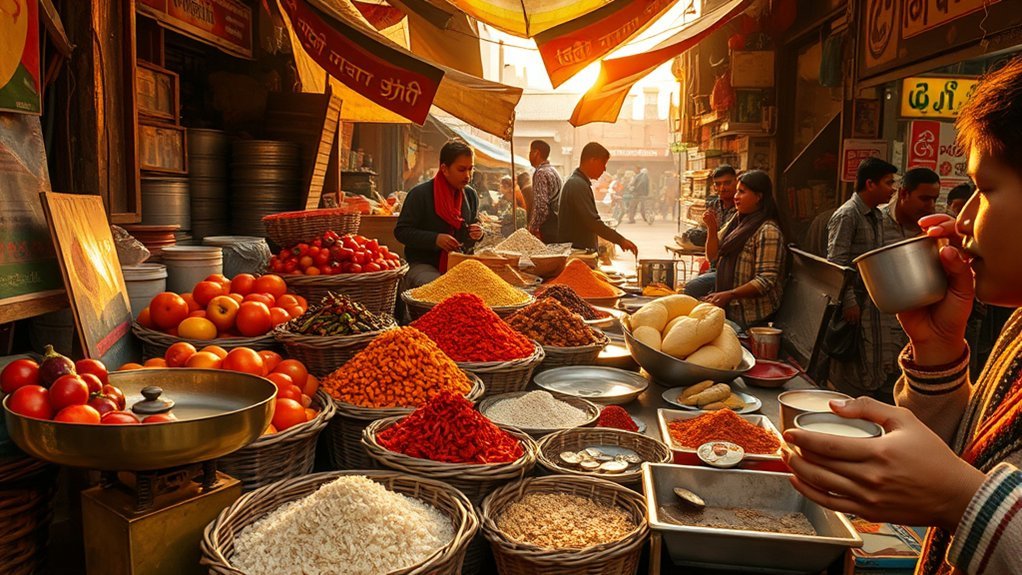
If you want affordable meals without sacrificing variety, Nepal delivers: a typical lunch runs about $1.74 versus $19.30 in the U.S.
You’ll see grocery and food costs stay low across venues. Street food and market produce let you cook cheaply — staples and fresh vegetables are a fraction of Western prices.
Grocery and food costs stay low—street food and market produce make cooking cheap, with staples far below Western prices.
Eating out remains economical: a dinner for two at a mid-range restaurant is about $18 (vs. $78.20 in the U.S.), and fast-food combos run near $6.95 (vs. $11.20).
Drinks follow the same pattern: a 0.5L beer in a pub is roughly $2.39 compared to $6.20 in the U.S., and a cappuccino averages $1.60 versus $5.25.
For budgeting, assume regular market shopping plus a couple of casual meals weekly; you’ll spend far less than in the U.S.
Transportation: Public Transit, Taxis, and Car Costs
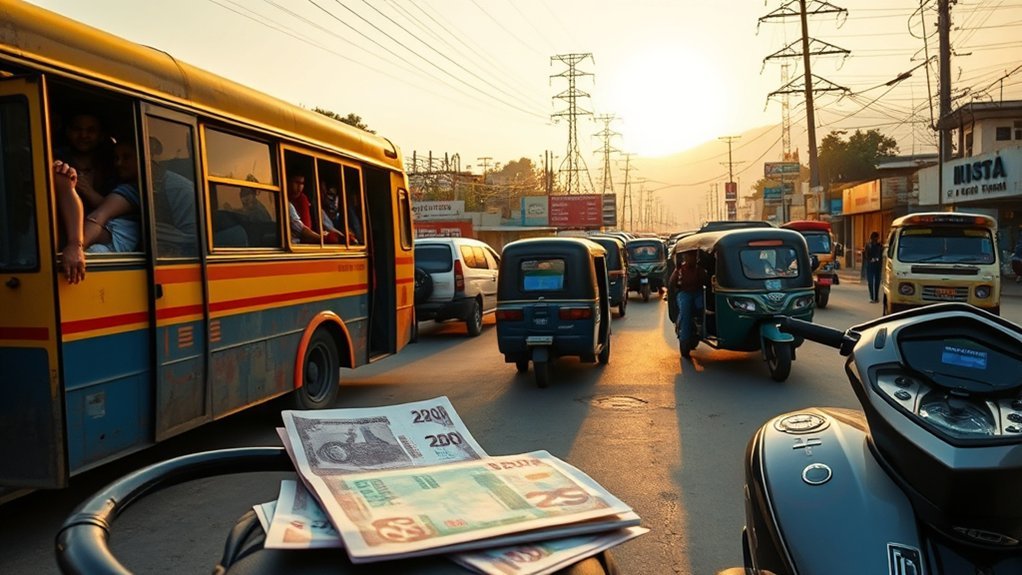
You’ll find very cheap public options in Kathmandu—microbuses and tempos usually cost $0.20–$0.50 per ride—so plan on using them for daily commutes.
Taxis start around $1 but meters aren’t common, so you’ll need to negotiate fares or use ride‑hailing apps that sometimes still require bargaining.
If you’re considering driving or renting a car, factor in $30–$50/day rental plus gasoline at about $1.12/liter.
Public Transport Options
Public transport in Kathmandu is a mix of crowded buses and microbuses with no fixed schedules, so you’ll often rely on local knowledge or flexibility to get around. Taxis are plentiful and cheap (typically $0.50–$1.00 per km, negotiated since meters are rarely used), while ride‑hailing apps like Pathao and Tootle offer convenient, competitively priced alternatives.
You’ll find public transportation unpredictable but extremely low-cost, taxis readily available, and ride-sharing apps reliable for short trips. Motorbike rentals cost about $5–$10/day with fuel ≈ $1/L, and bicycle rentals run $2–$5/day for short urban use.
Practical choices depend on your budget, comfort with traffic, and schedule needs:
- Cheapest: buses/microbuses — low fare, high unpredictability.
- Flexible: ride-sharing apps/taxis — slightly higher, convenient.
- Independent: motorbike or bicycle rentals — control vs. safety trade-offs.
Taxi Fares & Tips
After choosing between buses, ride‑shares, or renting your own wheels, you’ll want to understand taxi costs and bargaining tactics so you don’t overpay.
Taxi fares in Kathmandu are generally affordable, but meters are rarely used, so always negotiate a price before you get in. Expect typical city rides to run NPR 200–500 depending on distance and time of day; rush hours push prices higher.
Public microbuses and tempos cost NPR 15–30 and are the cheapest alternative. Learn basic Nepali phrases to negotiate more effectively and clarify routes and prices.
Keep small denominations of cash handy—drivers may not accept large bills or electronic payments. With upfront negotiation and local phrases, you’ll avoid surprises and manage transport costs precisely.
Utilities, Internet, and Mobile Data Expenses
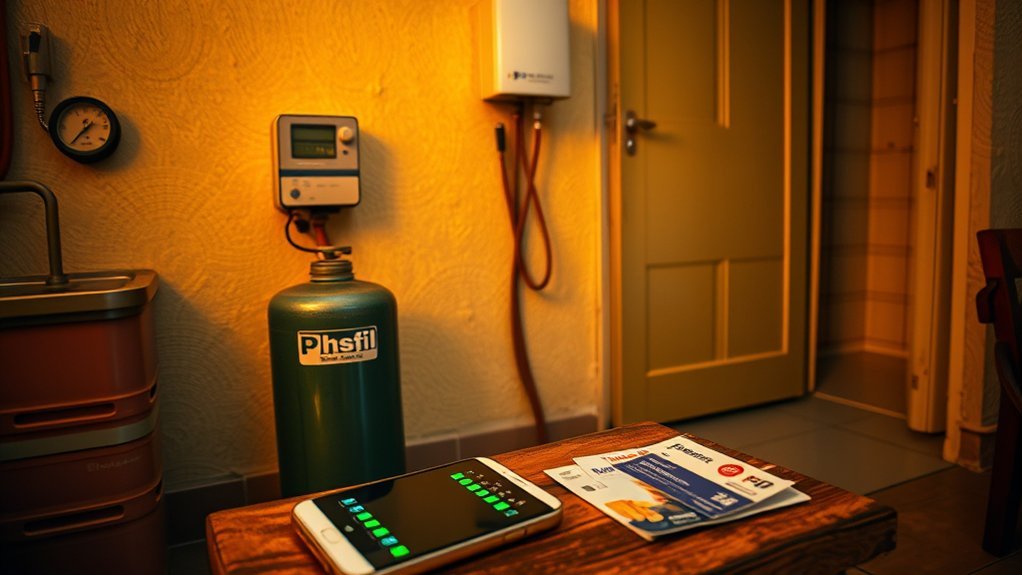
Although costs vary by city and season, utilities in Nepal are generally affordable: expect combined bills for electricity, heating, water, and garbage to run about $30–$50 per month, with electricity spiking in summer due to increased cooling use.
You’ll also budget separately for internet and mobile data expenses; high-speed home internet runs about $25–$40 monthly, while mobile plans are very cheap.
- Electricity & gas: Expect $30–$50 total for utilities most months; add $12–$15 for a cooking gas cylinder that lasts weeks, and anticipate higher electricity in summer from air conditioning.
- Internet: Choose plans in the $25–$40 range for reliable high-speed connections in cities; rural options may vary.
- Mobile data: A 15 GB monthly plan costs roughly $10–$15, which is enough for regular browsing, maps, messaging, and light streaming.
These numbers let you estimate monthly living costs precisely without overestimating connectivity or household energy needs.
Healthcare, Insurance, and Medical Costs
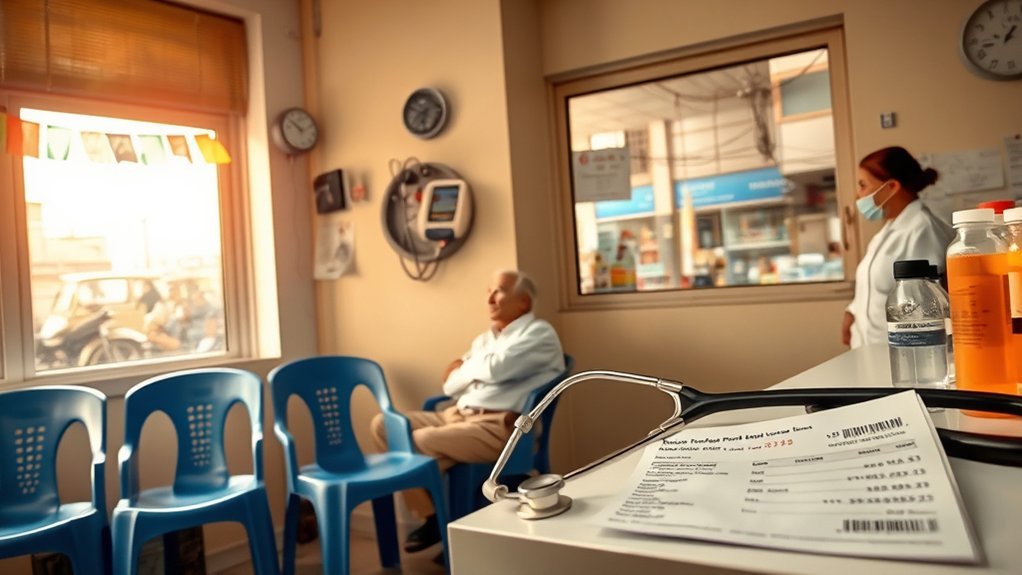
When you need care in Nepal, basic services are generally affordable—expect a typical doctor’s visit to cost about $16 versus roughly $121 in the U.S.—but quality varies between tourist hospitals and rural clinics, so you’ll want travel insurance for emergencies and referrals.
Healthcare at tourist hospitals is generally adequate, vaccinations are affordable, and common treatments are low-cost. Still, rural facilities can lack diagnostics and advanced care, so plan referral routes and emergency evacuation options through your insurer.
Food poisoning is common; avoid risky street food and uncooked items, and carry oral rehydration salts to treat dehydration immediately.
Budget for routine vaccinations, occasional clinic visits, and a solid travel insurance policy that covers hospital transfers and evacuation. If you stay long-term, assess expat or local private insurance plans for broader coverage.
Prioritize insurance that covers emergency transport and specialist referrals, since out-of-pocket costs remain low for routine care but can spike if you need advanced treatment or evacuation.
Entertainment, Gym, and Leisure Expenses
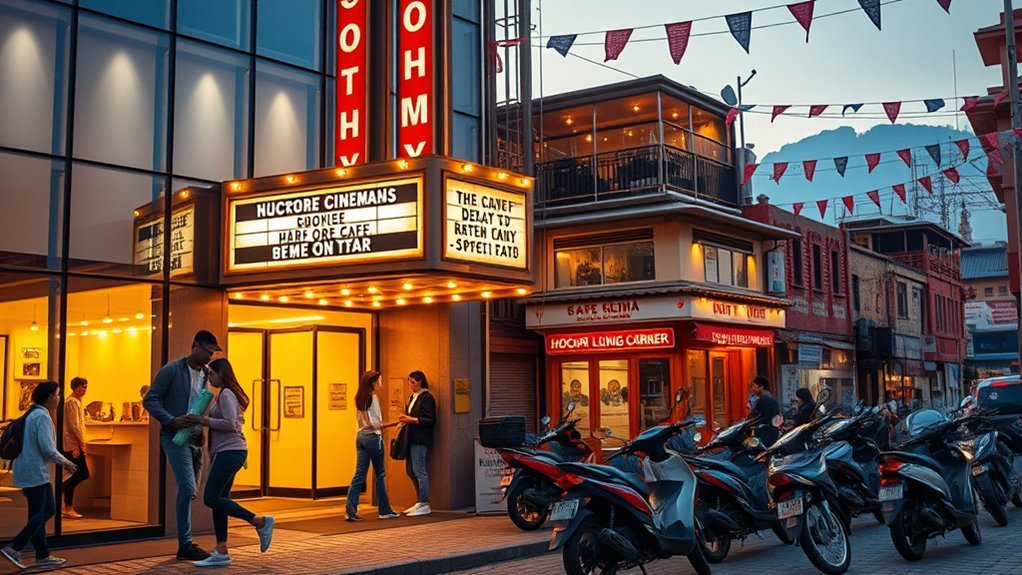
Entertainment and leisure in Nepal are particularly affordable: a gym membership runs about $22.50/month (vs. $52.10 in the U.S.), a cinema ticket is roughly $2.91 (vs. $14.20), and dinner for two averages $18 (vs. $78.20).
Entertainment in Nepal is remarkably cheap—gym $22.50/month, movies $2.91, dinner for two about $18.
So you can maintain an active social life and fitness routine at a fraction of U.S. costs. You’ll find fitness centers, boutique studios, and community gyms where a gym membership gives access to classes and equipment for much less than in Western cities.
Local bars, clubs, and cinemas keep social outings low-cost, and small services like haircuts (~$2.45) or a beer (~$2.39) further reduce leisure spending.
Prioritize what matters — regular workouts, nights out, or cultural experiences — and your monthly entertainment budget can stay modest.
- Gym membership: $22.50/month for typical access and classes.
- Movie night: $2.91 per ticket; great value for casual outings.
- Dinner for two: ~$18 at mid-range restaurants.
Visas, Permits, and Work-Related Financial Considerations
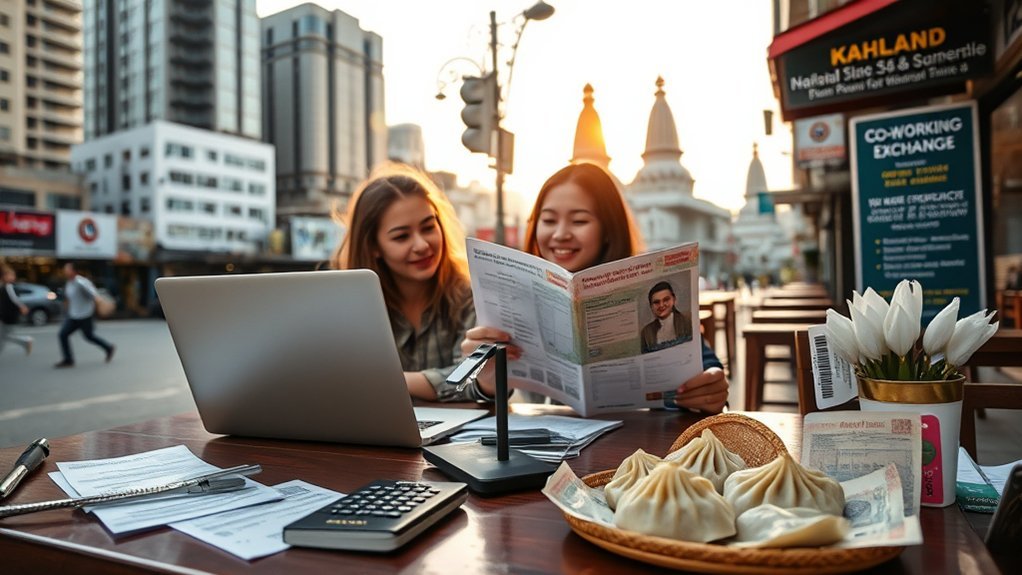
If you plan to live or work in Nepal, understand that visa and work-permit rules are specific and can affect your budget and timeline. Tourist visas arrive on entry for up to 90 days and extend to 150 days; factor extension fees and travel time into your cost of living in Nepal. Local work visas require recommendation letters and work agreements, adding administrative and possible agency costs. A digital nomad visa, expected by May 2025, will allow five-year multiple-entry stays but needs proof of income or bank balance plus valid travel insurance — budget for verification and insurance premiums. Learn cash-preferred local practices to avoid unexpected payment hurdles and legal issues.
| Requirement | Typical implication |
|---|---|
| Tourist visa | Short-term cost, extension fees |
| Work visa | Documentation, processing time |
| Nomad visa (2025) | Income proof, insurance costs |
Plan timelines and reserve funds for permits, verification, and compliance.
Practical Money-Saving Tips for Expats and Digital Nomads
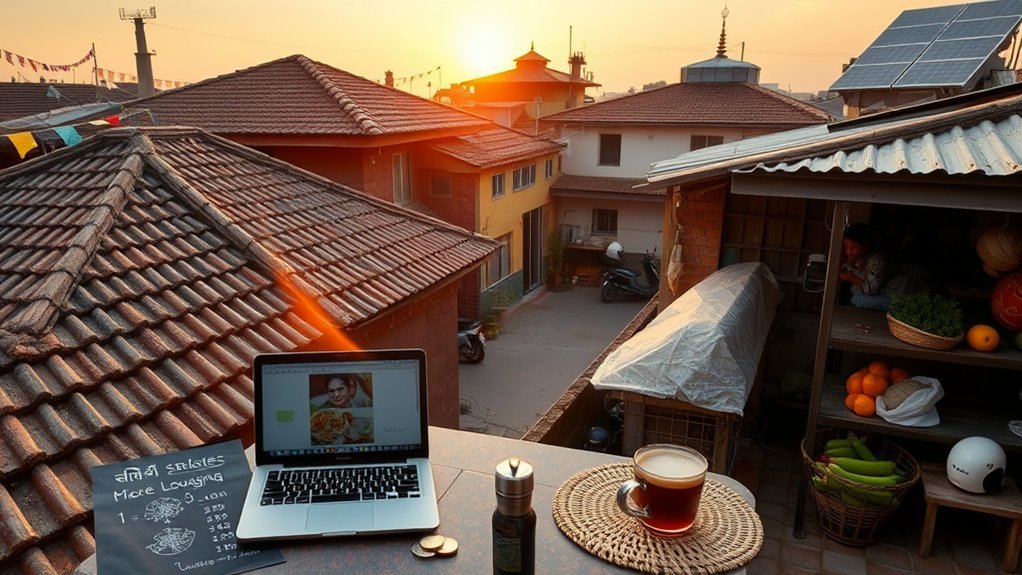
Because your Western salary can stretch far here, prioritizing local options will cut costs without sacrificing comfort: you’ll find the average cost of living in Nepal is low compared with the United States, so treat local goods and services as your baseline.
Aim for realistic per month budgets—many expats report living on roughly $500 CAD per month excluding rent—then add rent of $200–$500 for a one-bedroom in Kathmandu as needed.
As a Digital Nomad, focus on reliable, affordable internet (a 15 GB plan covers video calls) and negotiate taxi fares or use public transport to reduce daily expenses.
- Choose local meals and markets: food costs a few dollars per meal, trimming your food cost dramatically versus imported goods.
- Rent smart: pick neighborhoods where one-bedroom rent aligns with your per month target to maximize savings.
- Mobile and transport: buy a 15 GB plan for work and use buses or negotiated taxis to control commute cost.
These are the need to know tactics for living in Nepal.
Frequently Asked Questions
How Much Money Is Required to Live in Nepal?
You’d need about $500–$700 CAD monthly without rent; add roughly $200 CAD for a modern two-bedroom in Kathmandu, totaling around $700–$900 CAD monthly, depending on lifestyle, utilities, and occasional extras.
Can a US Citizen Live in Nepal?
Yes — you can: you’ll enter on a tourist visa (up to 90 days, extendable to 150), and with proof and qualifiers you can pursue longer options like the upcoming digital nomad visa, residence permits, or work/retirement routes.
Is 100 Dollars a Lot in Nepal?
Yes — $100 goes far in Nepal: you can cover about a week’s basic expenses, buy roughly 57 local meals, and afford groceries easily, though it won’t fully cover monthly city-center rent or long-term housing costs.
Is Nepal a Cheap Place to Live?
Is Nepal cheap to live in? Yes — you’ll find low housing ($200–$500/month in Kathmandu), inexpensive meals and transport, and affordable healthcare; if you earn a Western salary, you’ll live comfortably and often save substantially each month.
Conclusion
Think of Nepal as a well-mapped trekking route: you can sprint on a budget trail or choose a comfortable lodge for more cost. With modest rent ($150–$500/month outside Kathmandu), cheap street food ($1–$3), and low transport/utility bills, you’ll control your pace. Factor in insurance and occasional permit fees. Plan with data, pick your comforts deliberately, and you’ll navigate living costs here efficiently, reaching your financial summit without surprise avalanches.

